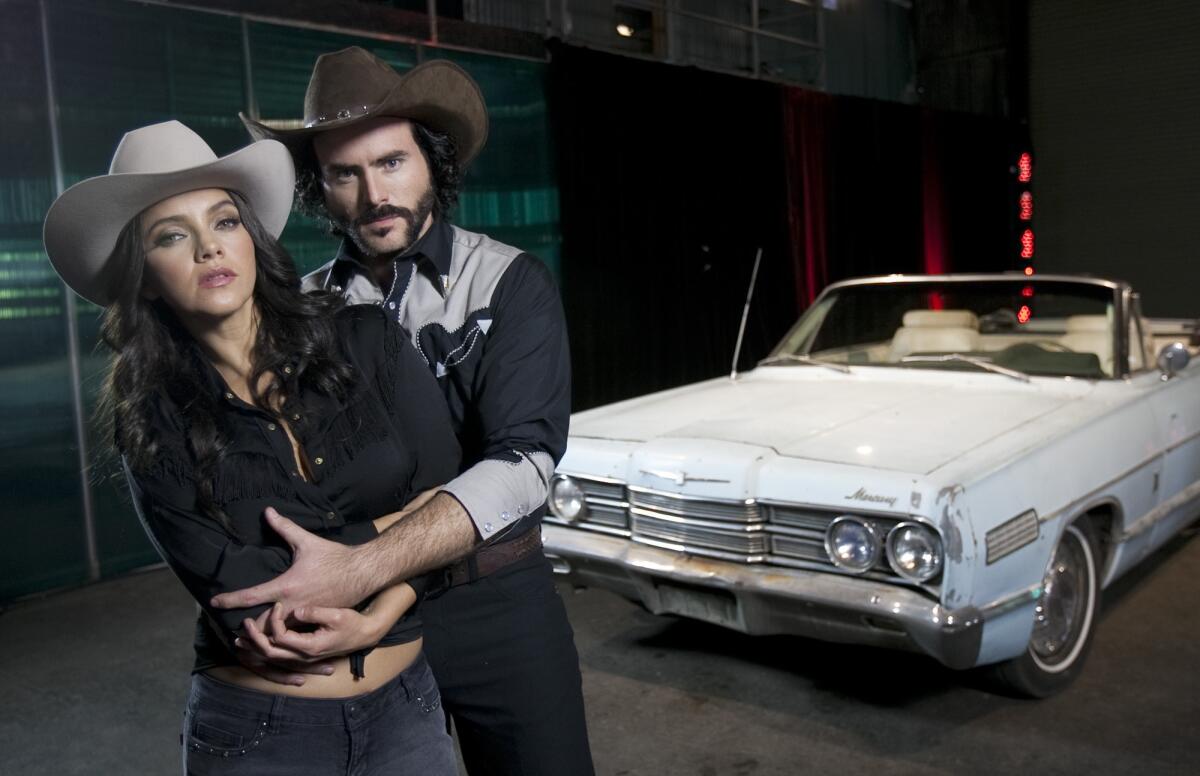1970s narco queen Camelia scores on Telemundo

Last month, after years of futile goose-chasing, Mexican authorities captured the country’s most-wanted criminal, the powerful Sinaloa drug cartel boss Joaquín “El Chapo” Guzmán. But another legendary Mexican desperado remains at large after 40 years, haunting the fantasies of an adoring public.
She’s Camelia la Texana, a comely San Antonio ingenue turned drug-smuggling queen who shot and killed her lover in a jealous rage. At least that’s her story as immortalized in “Contrabando y Traición” (“Contraband and Betrayal”), a Spanish-language corrido recorded by the Mexican American supergroup Los Tigres del Norte in the early 1970s.
Thanks to the classic tune’s wide cultural impact, Camelia’s fame has made the question of whether she actually existed largely irrelevant. Mexican tabloids have run interviews with at least two women claiming to be the real Camelia. Over the past 40 years, there’ve been Camelia-inspired spinoff books, cheesy flicks, even an opera that premiered last year in Long Beach.
“There was a surge of stories about narco-trafficking, very banal, very badly filmed, with low budgets, B movies,” said Mexican director Carlos Bolado, speaking by phone in Spanish.
The latest addition to the “Camelia” canon is a glossy, 60-episode series, directed by Bolado and shot in Mexico and the U.S., that began airing Feb. 25 on the Telemundo Network owned by NBCUniversal Television Group. It’s scheduled to debut in Mexico later this spring.
Developed by Campanario Entertainment, which workshops media content aimed at U.S. Latinos, and the Mexican production company Argos Televisión, the series easily ranks among Telemundo’s biggest and costliest ventures. Although the network wouldn’t disclose the budget, a spokesperson said it was comparable to the $10-million budget of Telemundo’s 2011 co-production “La Reina del Sur,” based on Arturo Pérez-Reverte’s novel and starring Kate del Castillo as a Mexican woman who becomes a narco empress in southern Spain.
The new series’ creators are banking that the public’s infatuation with such characters, like the global craving for illicit substances, is all but unquenchable. Spanish-speaking audiences, they believe, will be curious to know what happened to Camelia after the events described in Los Tigres’ tune but long before Mexico’s narco violence attained its present levels of indiscriminate viciousness. An estimated 70,000 people have died in drug-related violence in Mexico since 2006, when a federal government crackdown helped precipitate a murderous backlash.
“It’s in part a historic investigation,” series producer Tita Lombardo said of the new show. It is “important for us Mexicans to understand what is the origin of this thing that we are all living through now.”
PHOTOS: Behind the scenes of movies and TV
Telemundo is heavily promoting “Camelia la Texana” particularly in Southern California and other U.S. markets with large Latino populations. On its premiere night, according to Telemundo, the series reached a cumulative audience of 2.2 million viewers and outperformed all four general market broadcast networks in Los Angeles.
At a splashy February news conference in L.A.’s Arts District, Telemundo and Campanario representatives screened an eight-minute clip of series highlights, then took questions accompanied by the four main cast members. Sara Maldonado, 33, a Mexican telenovela star who landed the part of Camelia, and Erik Hayser, 32, who plays her feckless lover, Emilio Varela, arrived in a vintage Ford Thunderbird, sporting cowboy hats and doing their best to look predatory and seductive.
Maldonado described Camelia as “a woman who has a lot of values,” notably loyalty and resourcefulness. “The dream for any actress is to interpret a character like Camelia,” she said. “Camelia is good. She is only treated bad.”
To prepare for their roles, the actors received a crash course in ‘70s-era firearms and fashion statements as well as coaching in borderland accents and idiomatic phrases.
“We made a translation, lectures and essays, about what went on during that epoch, a ‘back to the past,’ of how they talked, what kind of words did they use,” said Andrés Palacios, the Chilean actor who plays an honest cop surrounded by colleagues who are just as venal as the narcos.
Hayser said that the binational nature of the series’ production underscored the trans-border nature of the drug problem.
“It’s a story that deals with what has been going on in the United States and what’s been going on in Mexico since the ‘70s, when alliances were created among the narco-traffickers,” he said. “And not only this. It speaks historically about the migration of Mexicans to the United States, how these routes were created in the first place in order to transport humans into the United States and then were used to transport drugs.”
For Telemundo, the series signals an increasing willingness to compete in prime-time television. Alfredo Richard, the network’s senior vice president of communications and talent strategy, said the network is “doubling down” its efforts in the lucrative 10 p.m. weeknight slot, following the late-night success of two other recent Telemundo co-productions: “La Reina del Sur” and “El Señor de los Cielos” (“The Lord of the Skies”), which began airing last summer and is heading into its second season.
Like “Camelia,” those programs were hybrids of Mexican telenovelas and U.S.-style dramatic series and had relatively large budgets for a Spanish-language production. “Camelia,” with a production crew of more than 200, and 97 actors, has more personnel than either of its predecessors.
Asked where the series draws the line between dramatizing the drug wars and exploiting them, Richard replied that “Camelia” establishes “very clearly from the beginning that crime doesn’t pay and that the life these people live is miserable and that really this is not an apology to living the gangster life.”
PHOTOS: Celebrities by The Times
Telemundo officials prefer to describe “Camelia la Texana” as essentially a romantic drama, threaded with themes of familial relationships, action sequences and occasional comic touches.
Bolado has experience with making period movies about bitterly controversial topics, having directed such well-received feature films as “Colosio: El Asesinato” (2012), about the 1994 murder of a Mexican presidential candidate, and “Tlatelolco, Verano de 68” (2013), about Mexico’s violently repressed student demonstrations before the 1968 Olympic Games.
He said it would have been harder to make a series about a narco queen set in the bloody early 21st century rather than in the early 1970s. But, as with another current film, “American Hustle,” Bolado believes that its vintage setting will allow “Camelia la Texana” to adopt a certain historical distance from its subject. He hopes that distance will encourage viewers to ask themselves certain questions.
“How did we get to this point?” Bolado said. “What happened? How do we change it?”
More to Read
The biggest entertainment stories
Get our big stories about Hollywood, film, television, music, arts, culture and more right in your inbox as soon as they publish.
You may occasionally receive promotional content from the Los Angeles Times.











